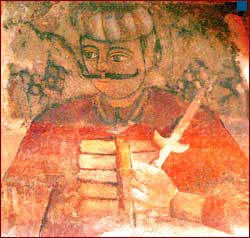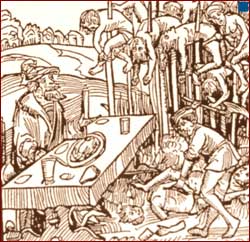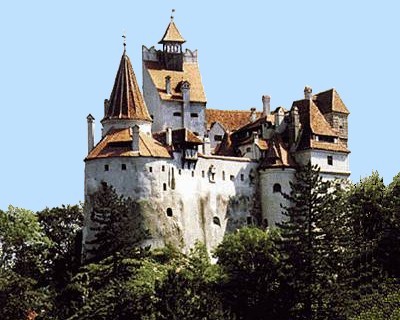| Entrance | Mainstreet | Wiki | Register |
|
# of watchers: 14
| D20: 16 |
| Wiki-page rating |  Stumble! Stumble! |
| Informative: | 0 |
| Artistic: | 0 |
| Funny-rating: | 0 |
| Friendly: | 0 |
 My first memories of Vlad Tepes date from my early childhood, when my mother and my grandmother fed my imagination with stories and legends about the loved and respected voivode of Wallachia. They told me about his bravery and patriotism, about his fights against the Ottoman Empire, about Him, Vlad, the fighter for justice and freedom, turning him into one of my heroes, along with Stephan the Great, voivode of Moldavia.
My first memories of Vlad Tepes date from my early childhood, when my mother and my grandmother fed my imagination with stories and legends about the loved and respected voivode of Wallachia. They told me about his bravery and patriotism, about his fights against the Ottoman Empire, about Him, Vlad, the fighter for justice and freedom, turning him into one of my heroes, along with Stephan the Great, voivode of Moldavia. The historians that study Vlad Tepes have two theories about the etymology of the name “Draculea” that Vlad used on several official papers, a name that nowadays turned into “Dracula”. The first one speaks about the Order of the Dragon, the other one, preferred by most of the philologists, states that “Draculea” has been derived from the royal family name “Dragulesti” or “Dragulii”.
The historians that study Vlad Tepes have two theories about the etymology of the name “Draculea” that Vlad used on several official papers, a name that nowadays turned into “Dracula”. The first one speaks about the Order of the Dragon, the other one, preferred by most of the philologists, states that “Draculea” has been derived from the royal family name “Dragulesti” or “Dragulii”.| Vlad III Tepes was born in 1430 or 1431, at Sighisoara, in Transylvania, his parents being Vlad II Dracul and Lady Chiajna. He had three brothers: Mircea, from a previous marriage of his father, Vlad (half-brother, later known as Vlad IV the Monk) and Radu, the youngest one, later known as Radu the Handsome. When Vlad II came back in Wallachia, the sultan Murad II threatened him with invasion so he would become the Turks’ vassal. Vlad had to accept and sent his two younger sons to Istanbul in 1442 as a token of his loyalty. Radu quickly accepted the Turks habits and became a favourite of the soon to be sultan Mehmed II, while Vlad developed a deep hatred against the two of them. Legends say that he pretended to want to enroll the Ottoman army, so that he can find out everything about its organization, tactics and other inside things that would later help him win over the Turks. At the death of Vlad II and his son Mircea in 1447, the young Vlad Tepes has been set free and informed about the situation in Wallachia. The actual king was Vladislav II, guilty of the two murders. Willing to revenge, full of hatred and pain, Vlad tries to become king and kill Vladislav, with the help of the sultan, who gave him a small Ottoman army so he can become the puppet voivode of Wallachia, at the orders of Murad. Unfortunately, Vlad is chased from the throne two months later by Vladislav. Until 1456, he lives at the court of Iancu de Hunedoara, also known as Ioan Huniade or John Hunyadi, where he meets and becomes friend of Stephan, future king of Moldavia under the name of Stephan the Great. |  The only existing representation of Vlad II |
 | Having no allies and an army three times lesser than the sultan’s, Vlad had to retreat to Targoviste, burning down the fields and poisoning the fountains to cut off the Turks’ resources. and lead a guerilla war. When finally Mehmed arrived in front of the capital, he was confronted to a horrifying view: the impaled heads of 20.000 Turks looking at him with their dead eyes, a scene that remained in history under the name of “Tepes’ Forest”. Tired, hungry and with their nerves tensed to the limit, the sultan and the majority of his officers decided to retreat. Such a surprising event, that even Victor Hugo mentioned it in his “Legends of the Centuries” (“Légendes des Siècles”). On his way home, Mehmed II left Vlad’s younger brother, his favourite Radu, on the throne in Bucharest, along with some of the army, so he can continue the campaign. Radu followed Vlad during his retreat for the fortress of Poenari; fortunately, Vlad managed to escape through a secret tunnel through the mountains, then, with the help of some peasants, he reached the Arefu village, and from there he left for the Bran castle in Transylvania, seeking for help from the king of Hungary, Matei (Mathias) Corvin, successor of John Hunyadi (which, you might recall, had offered Vlad shelter and help years before).But, surprisingly, the king ordered the arresting and imprisonment of Vlad at Visegrad, not far from Pesta. The reason? Fake letters brought to the king by the boyars that disapproved Vlad’s political decisions, saying that the voivode would have made a deal with the sultan, promising help for conquering Hungary in change for the throne of Wallachia. |
| Chronicles Born in 1423, Laonic Chalcocondil is one of the most respected historians who wrote about Mehmed II and his expedition against Wallachia in 1462, based on oral-transmitt | Literature A synthesis of the stories spread by the Germans from Transylvania is Michael Beheim’s poem “About a Tyrant Named Dracula from Wallachia” (1462). Inspired by the same stories, Fischaret mentions Vlad as a bloodthirsty beast in his “Flohhatz". Victor Hugo, inspired by Dimitrie Cantemir’s “History of the Ottoman Empire”, mentions Vlad in his “Soultan Mourad” (1743) as a Wallach boyar that refused to pay the tribute. Of course, Bram Stoker and his novel “Dracula” is the writer that has become the most famous after exploiting the character Dracula. But Stoker inspired from the German stories, which (if you remember their hatred towards Vlad) describe the voivode as a cruel tyrant. He has never been either to Transylvania, nor to Wallachia, hence he could not know anything about the real Vlad. Moreover, the one who reads carefully the novel will see that Dracula says about himself being related to Vlad Tepes, and not Vlad (approximate quote: “Who was, if not one my family, the voivode that crossed the Danube and beaten the Turks on their own territory?”). Quod erat demonstrandum. |
 Due to Stoker, Romania is now invaded by thousands of tourists coming, ironically, for something that didn’t exist and isn’t Romanian. For us, the Bran Castle was the residence of Queen Maria. Tell this, as a guide, to a foreign tourist, and explain him the real history of Bran. The said tourist will listen for a minute, then yawn, look at his clock, yawn again, then ask “Okay, how about Dracula?”. He had heard about the bloody vampire, and he wants to see the bloody vampire! A moment where I, if I was guide, would slap him with a Dracula made in China toy until some of his brain starts working.
Due to Stoker, Romania is now invaded by thousands of tourists coming, ironically, for something that didn’t exist and isn’t Romanian. For us, the Bran Castle was the residence of Queen Maria. Tell this, as a guide, to a foreign tourist, and explain him the real history of Bran. The said tourist will listen for a minute, then yawn, look at his clock, yawn again, then ask “Okay, how about Dracula?”. He had heard about the bloody vampire, and he wants to see the bloody vampire! A moment where I, if I was guide, would slap him with a Dracula made in China toy until some of his brain starts working. 2008-10-05 [Chrysilla]: If you need a hand, I'll gladly help. I had a problem with someone here on ET who claimed to have done serious research on him, but her article was full of errors; so we argued because she kept saying I was wrong and I had no right to say her work wasn't good. This is how this wiki was created. *sigh*
2008-10-05 [Linn Scarlett]: Ew how annoying. Well I won't claim my article will be perfect (I am firmly in the truth-between-
My article all started with making a historical acceptable reconstruction of Vlad, his time, his surroundings and his person an sich. Which managed to wrap me up for the last few weeks >.>'
2008-10-05 [Linn Scarlett]: Which reminds me, I recently got my hands on an older (i think moldavian?) bank note with Stephan on it. (I collect money as one of my odd sorted hobbies) which made me wonder if there is actually (modern) money from the eastern regions with Vlad on it?
Oh, and in spite of the bigger philosophical meaning *clears throat* "No one is truely dead until forgotten"
And I personally, would rather even live on as a myth with little truth of me known, than being forgotten entirely and damned to the oblivion that is the end of human memory
2008-10-05 [Chrysilla]: "No one is truely dead until forgotten", I love this idea since I first read it (and don't ask me where, because I don't remember XD). It can be the start of a beautiful, interesting discussion.
As for the money, no, not as far as I know. Stephan ruled for 47 years and was a more important figure for Moldavia's history than Vlad was for Wallachia (unfortunately, because if Vlad had had the same destiny, many things will be completely different now). This is why I don't know if Vlad will be on our money *shrugs*
2008-10-05 [Linn Scarlett]: *shrugs back* it was worth a shot? I figured someone must have done something a few years back when it was like his 450th birthday or some such. Trust somebody to make a big deal out of it ;)
Anyway, I got the one with Stephan on it, for some reason I just couldn't let it lying there on the street. As if having it would somehow help me with writing or some silly notion. I don't know. Maybe just my love for old and foreign money.
2008-10-05 [Chrysilla]: Then remind me to ask my sisters to bring some old paper money that I left home, when they come over for the wedding (I don't trust my short term memory enough...)
Anyway I found this site http://www.ats
2008-10-05 [Linn Scarlett]: I'll try too ^_^ My memory isn't too good either
Oh and thanks for the site! I'll go through it just to be sure :p
2008-10-05 [Linn Scarlett]: Also, I am writing (as I mentioned before) a story involving Vlad with a friend, and I wondered if you could perhaps help me with a little get-on in Romanian/Hunga
2008-10-06 [Chrysilla]: Sure I can help, but not for the Hungarian words (I never learnt that language). As for tuica, it was absolutely surely known at that time (it is mentioned in several ancient writings), I guess palinca too, given that it's almost the same drink.
2008-10-06 [Linn Scarlett]: The earliest dates I could find on palinca were 1331 AD, from a script in which a monk or some such mentions it. The other two I couldn't find.
2008-10-06 [Linn Scarlett]: Well, I am trying to mix some words into the story, such as titles and formalities mainly
2009-06-25 [Linn Scarlett]: Oh my God Deedee, we haven't had spam here in nearly a year o.O what happened to the emo kids?
2009-06-25 [Chrysilla]: They're still in the cave, waiting for uncle D., why? :p
2009-06-25 [Linn Scarlett]: Geh. So it would seem. "everybody has a vampire smile". Why are you not on msn talking to me? I have time for a change :O
2009-06-25 [Chrysilla]: Cause I was having dinner, you know, the one I chocked with because of your message XD
2009-06-25 [Linn Scarlett]: Oh yea :P
2010-11-20 [Alexi Ice]: Hello! Congrats! Your WIKI has now been featured on mainstreet under the featured wiki section!
2010-12-06 [Falx]: This wiki is one of the most awesome things I have read in a long time. Makes me want to cheer! HUZZAH!
2010-12-25 [One]: I was always told Dracul was his name, Tepes (meaning impailer) was his title, no?
2011-04-10 [Chrysilla]: @Akane: thank you very much!
@Sliverbane: I'm glad you did :) Most welcome.
@Falx: Aww, thank you ^^
@One: Vlad was his first name, Dracul was his father's surname and Tepes was his own surname. He was also sometimes called DraculEA, meaning "the son of Dracul (devil)" or "the little devil". But it was rare.
Number of comments: 40 | Show these comments on your site |
|
Elftown - Wiki, forums, community and friendship.
|